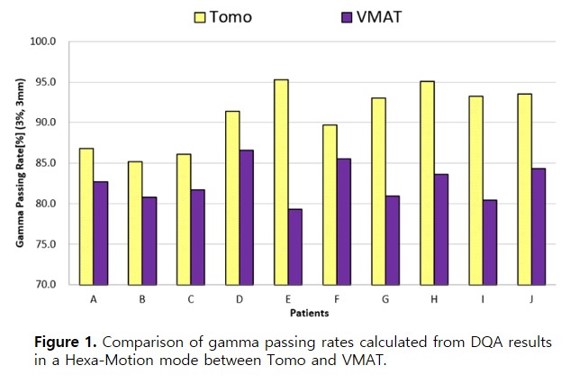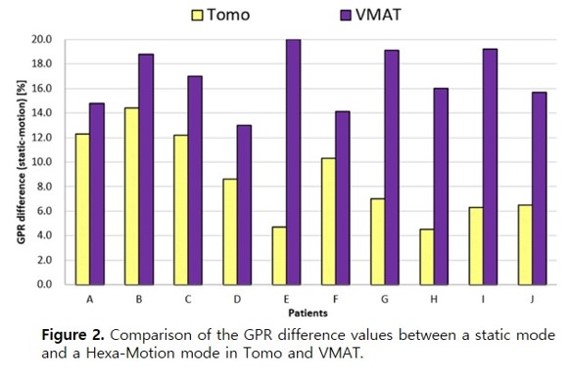comparison of dosimetric error due to the tumor motion between TomoTherapy and LINAC-based VMAT
Ju-Young Song,
Korea Republic of
PO-1907
Abstract
comparison of dosimetric error due to the tumor motion between TomoTherapy and LINAC-based VMAT
1Chonnam National University Medical School, Radiation Oncology, Gwangju, Korea Republic of
Show Affiliations
Hide Affiliations
Purpose or Objective
In this study, we analyzed the difference in dosimetric error due to tumor motion in an ITV-based IMRT process based on the IMRT method using the Delta4 Hexa-Motion system. Among the IMRT methods, the conventional LINAC-based VMAT technique and the helical-based TomoTherapy technique were selected for a comparison analysis of the dosimetric error due to tumor motion.
Material and Methods
ITV-based IMRT plans for a total of 10 cases of liver cancer were prepared in TomoTherapy (Tomo) and LINAC-based VMAT. Delivery quality assurance (DQA) plans were created using Delta4 phantom for the verification of dosimetric accuracy of the established Tomo and VMAT plans. DQA measurements were performed in both the static mode and the Hexa-Motion mode by using the Delta4 Hexa-Motion system in Tomo and VMAT. The dose variations were compared and analyzed for each treatment method in order to evaluate the effect of a target motion on the IMRT dosimetric error.
Results
In the static mode, the average gamma passing rate (GPR) using a 3% dose difference/3 mm distance to agreement criteria was 99.61% in Tomo and 99.35% in VMAT, which confirmed sufficient dosimetric accuracy in both IMRT methods. Figure 1 shows a comparison of GPRs calculated from DQA results in the Hexa-Motion mode between Tomo and VMAT. The calculated average GPR values based on the 3%/3 mm criteria were 90.93% in Tomo and 82.58% in VMAT, indicating that the dosimetric error under the motion conditions was relatively less in Tomo compared with that in VMAT. As shown in Figure 2, the GPR difference values of VMAT were larger in all the cases analyzed, indicating that Tomo had less dosimetric error than VMAT in the motion condition. The average GPR difference in Tomo was 8.68%, which was 8.09% lower than value of 16.77% in VMAT. A t-test was performed to verify whether statistically significant difference occurred in the degree of the GPR value decrease for Hexa-Motion between Tomo and VMAT. The calculated p-value for the GPR differences between Tomo and VMAT was 0.00018, which confirmed the statistical significance of the GPR difference.


Conclusion
This study verifies that the dosimetric error of ITV-based IMRT due to the tumor motion was larger in VMAT than in Tomo. Also, Tomo can be considered to be more suitable than the conventional LINAC-based VMAT method in terms of the dosimetric accuracy of ITV-based IMRT for the treatment of a moving tumor.